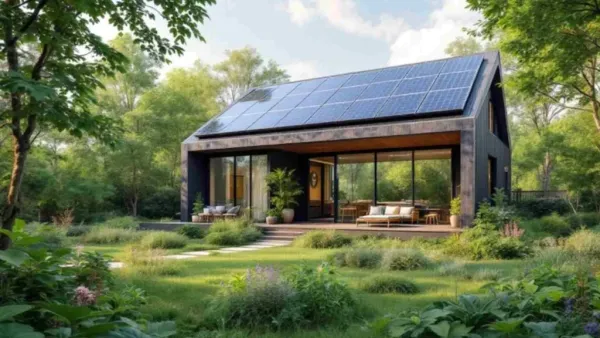Haresh Mirpuri, a second-generation entrepreneur and the founder of Essensai067 believes sustainable architecture should be something that harmonises with the community and environment. With Essensai067, a 5.16-acre sustainable retail development in Bangalore, Mirpuri says the space has been designed as a community-focussed retail enclave that integrates solar energy, rainwater harvesting, and organic waste conversion into its infrastructure, proving that retail can be regenerative. In a conversation with ETDigital, Mirpuri talks about critical design principles in sustainable architecture, how a building can be truly net-zero and the need to find a balance between the cost of a project and protecting the environment. Edited excerpts.
Economic Times (ET): What does a “sustainable building” mean to you beyond the technical certifications like LEED or IGBC?
Haresh Mirpuri (HM): A sustainable building transcends certifications. It’s about creating spaces that harmonise with their environment and community. At Essensai067, sustainability is integrated into every facet, from repurposing excavated soil into low-carbon earth blocks to achieving net-zero water discharge through advanced recycling systems. It’s about designing buildings that are not only environmentally responsible but also culturally and socially enriching.
ET: How can architecture shape behaviour toward more sustainable living?
HM: Architecture can subtly guide occupants toward sustainability by embedding eco-friendly practices into the design. At Essensai067, passive cooling systems, ample natural lighting, and strategic spatial layouts reduce the need for artificial energy sources, thereby nudging occupants towards more conscious energy usage. Thoughtfully placed green spaces and visible sustainability features, such as water recycling systems and solar power panels, reinforce occupants’ awareness and encourage environmentally responsible behaviours through everyday interactions with their built environment.
ET: What are the most critical design principles for creating a truly sustainable building?
HM: One of our core principles was climate-responsive architecture—our buildings are oriented and designed to harness natural light, cross-ventilation, and passive cooling, reducing the need for artificial systems. We prioritised material circularity, using low-carbon earth blocks made from excavated soil and reusing construction waste wherever possible. Water sustainability was equally vital, achieved through rainwater harvesting, zero water discharge, and full recycling of grey and black water. Flexibility and longevity were also built into the design, ensuring the spaces can adapt to evolving needs without demolition or waste. Most importantly, we designed with the conviction that sustainability is not a feature—it’s the foundation. Every line drawn and brick laid reflects that belief.
ET: How early in the planning process should sustainability considerations be introduced?
HM: Sustainability should be a foundational element, integrated from the project’s inception. Early planning allows for the incorporation of site-specific strategies, such as optimal building orientation for solar gain or the preservation of natural landscapes, ensuring that sustainability is not an afterthought but a guiding principle.
ET: How do you balance sustainability with aesthetics and functionality?
HM: Sustainability, aesthetics, and functionality are not mutually exclusive; they can complement each other. At Essensai067, the use of low-carbon earth blocks made from excavated soil and steel beams not only reduces environmental impact but also contributes to the site’s unique visual identity.
ET: What are some innovative or traditional materials that support low-carbon construction?
HM: One of the most innovative materials we used was low-carbon earth blocks made from the site’s own excavated sand—this not only reduced transportation emissions but also cut embodied energy by nearly 30% compared to conventional concrete blocks. We also reused structural elements from the existing spinning mill, preserving embodied carbon and reducing new material demand.
ET: You have recently opened Essensai067. How does the building integrate climate-responsive architecture, solar energy, and water reuse systems? What were the biggest challenges in achieving net-zero energy and water goals in an urban Indian context?
HM: At Essensai067, we approached sustainability through an integrated lens, beginning with climate-responsive architecture. The building orientation, spatial layout, and material choices were all designed to reduce dependency on mechanical cooling. Passive strategies like high ceilings, natural ventilation, and thermal mass help maintain indoor comfort with minimal energy use. We’ve installed a substantial solar energy system that offsets a significant portion of our power needs. The facility harnesses over 750 kW of solar energy. On the water front, we’ve implemented rainwater harvesting, greywater recycling, and blackwater treatment, achieving zero water discharge from the site. One of the biggest challenges was adapting these systems to an urban Indian context, where infrastructure constraints and unpredictable regulatory processes can delay implementation. Retrofitting sustainable solutions into a former industrial site also required creative problem-solving to balance heritage, aesthetics, and function—without compromising environmental integrity.
ET: With over 100 of 120 trees preserved or transplanted during construction, how did ecological preservation influence the design and layout of the site?
HM: Ecological preservation was central to Essensai067’s design philosophy. The existing trees were not obstacles, but integral elements that influenced building placement and orientation. This approach not only maintained the site’s biodiversity but also enhanced the microclimate, contributing to the building’s passive cooling strategy.
ET: Can a building be truly net-zero in a dense urban setting?
HM: Achieving true net-zero status in a dense urban setting is extremely challenging—but not impossible. It requires a convergence of smart design, advanced technology, and long-term operational discipline. In cities like Bengaluru, constraints such as limited space for solar panels, inconsistent municipal infrastructure, and high energy demands make full net-zero difficult to realize. At Essensai067, while we’ve significantly reduced our environmental footprint through climate-responsive architecture, water recycling systems, and on-site solar generation, we also acknowledge the limitations of our urban context. Our goal is to get as close to net-zero impact as possible—not just in energy and water use, but in how we build, operate, and engage with the surrounding ecosystem.
ET: How do you address the perception that sustainable buildings are more expensive to build?
HM: While initial costs may be higher, sustainable buildings offer long-term savings through reduced energy and water bills. Moreover, they provide intangible benefits like improved occupant well-being and environmental stewardship. At Essensai067, the investment in sustainability has resulted in a space that is not only cost-effective over time but also aligns with our commitment to responsible development.
ET: You have another business called Aranyani, which is into luxury handbags. It emphasises craftsmanship with techniques like hand embroidery, gemstone setting, and 24-karat gold gilding. How do you reconcile such opulence with your commitment to sustainability?
HM: Aranyani embodies the philosophy of ‘responsible luxury.’ Aranyani sources leather only from tanneries that practice wastewater detoxification and recycling. It has actively worked on transitioning towards chrome-free, vegetable-dyed leathers and avoiding exotic leathers entirely, using hides from animals only raised for meat. The company has also implemented efficient cutting techniques to reduce material waste. These practices are part of Aranyani’s broader mission to eliminate hazardous materials and become zero-waste by 2026
ET: Looking ahead, how do you envision the role of spaces like Essensai067 and brands like Aranyani in promoting sustainability and cultural richness in urban India?
HM: Spaces like Essensai067 and brands like Aranyani serve as beacons for a future where sustainability and cultural heritage coexist. They demonstrate that urban development can honour traditional craftsmanship, foster community engagement, and prioritise environmental responsibility. By setting such examples, we hope to inspire a broader movement towards sustainable living that is deeply rooted in cultural appreciation.
Economic Times (ET): What does a “sustainable building” mean to you beyond the technical certifications like LEED or IGBC?
Haresh Mirpuri (HM): A sustainable building transcends certifications. It’s about creating spaces that harmonise with their environment and community. At Essensai067, sustainability is integrated into every facet, from repurposing excavated soil into low-carbon earth blocks to achieving net-zero water discharge through advanced recycling systems. It’s about designing buildings that are not only environmentally responsible but also culturally and socially enriching.
ET: How can architecture shape behaviour toward more sustainable living?
HM: Architecture can subtly guide occupants toward sustainability by embedding eco-friendly practices into the design. At Essensai067, passive cooling systems, ample natural lighting, and strategic spatial layouts reduce the need for artificial energy sources, thereby nudging occupants towards more conscious energy usage. Thoughtfully placed green spaces and visible sustainability features, such as water recycling systems and solar power panels, reinforce occupants’ awareness and encourage environmentally responsible behaviours through everyday interactions with their built environment.
ET: What are the most critical design principles for creating a truly sustainable building?
HM: One of our core principles was climate-responsive architecture—our buildings are oriented and designed to harness natural light, cross-ventilation, and passive cooling, reducing the need for artificial systems. We prioritised material circularity, using low-carbon earth blocks made from excavated soil and reusing construction waste wherever possible. Water sustainability was equally vital, achieved through rainwater harvesting, zero water discharge, and full recycling of grey and black water. Flexibility and longevity were also built into the design, ensuring the spaces can adapt to evolving needs without demolition or waste. Most importantly, we designed with the conviction that sustainability is not a feature—it’s the foundation. Every line drawn and brick laid reflects that belief.
ET: How early in the planning process should sustainability considerations be introduced?
HM: Sustainability should be a foundational element, integrated from the project’s inception. Early planning allows for the incorporation of site-specific strategies, such as optimal building orientation for solar gain or the preservation of natural landscapes, ensuring that sustainability is not an afterthought but a guiding principle.
ET: How do you balance sustainability with aesthetics and functionality?
HM: Sustainability, aesthetics, and functionality are not mutually exclusive; they can complement each other. At Essensai067, the use of low-carbon earth blocks made from excavated soil and steel beams not only reduces environmental impact but also contributes to the site’s unique visual identity.
ET: What are some innovative or traditional materials that support low-carbon construction?
HM: One of the most innovative materials we used was low-carbon earth blocks made from the site’s own excavated sand—this not only reduced transportation emissions but also cut embodied energy by nearly 30% compared to conventional concrete blocks. We also reused structural elements from the existing spinning mill, preserving embodied carbon and reducing new material demand.
ET: You have recently opened Essensai067. How does the building integrate climate-responsive architecture, solar energy, and water reuse systems? What were the biggest challenges in achieving net-zero energy and water goals in an urban Indian context?
HM: At Essensai067, we approached sustainability through an integrated lens, beginning with climate-responsive architecture. The building orientation, spatial layout, and material choices were all designed to reduce dependency on mechanical cooling. Passive strategies like high ceilings, natural ventilation, and thermal mass help maintain indoor comfort with minimal energy use. We’ve installed a substantial solar energy system that offsets a significant portion of our power needs. The facility harnesses over 750 kW of solar energy. On the water front, we’ve implemented rainwater harvesting, greywater recycling, and blackwater treatment, achieving zero water discharge from the site. One of the biggest challenges was adapting these systems to an urban Indian context, where infrastructure constraints and unpredictable regulatory processes can delay implementation. Retrofitting sustainable solutions into a former industrial site also required creative problem-solving to balance heritage, aesthetics, and function—without compromising environmental integrity.
ET: With over 100 of 120 trees preserved or transplanted during construction, how did ecological preservation influence the design and layout of the site?
HM: Ecological preservation was central to Essensai067’s design philosophy. The existing trees were not obstacles, but integral elements that influenced building placement and orientation. This approach not only maintained the site’s biodiversity but also enhanced the microclimate, contributing to the building’s passive cooling strategy.
ET: Can a building be truly net-zero in a dense urban setting?
HM: Achieving true net-zero status in a dense urban setting is extremely challenging—but not impossible. It requires a convergence of smart design, advanced technology, and long-term operational discipline. In cities like Bengaluru, constraints such as limited space for solar panels, inconsistent municipal infrastructure, and high energy demands make full net-zero difficult to realize. At Essensai067, while we’ve significantly reduced our environmental footprint through climate-responsive architecture, water recycling systems, and on-site solar generation, we also acknowledge the limitations of our urban context. Our goal is to get as close to net-zero impact as possible—not just in energy and water use, but in how we build, operate, and engage with the surrounding ecosystem.
ET: How do you address the perception that sustainable buildings are more expensive to build?
HM: While initial costs may be higher, sustainable buildings offer long-term savings through reduced energy and water bills. Moreover, they provide intangible benefits like improved occupant well-being and environmental stewardship. At Essensai067, the investment in sustainability has resulted in a space that is not only cost-effective over time but also aligns with our commitment to responsible development.
ET: You have another business called Aranyani, which is into luxury handbags. It emphasises craftsmanship with techniques like hand embroidery, gemstone setting, and 24-karat gold gilding. How do you reconcile such opulence with your commitment to sustainability?
HM: Aranyani embodies the philosophy of ‘responsible luxury.’ Aranyani sources leather only from tanneries that practice wastewater detoxification and recycling. It has actively worked on transitioning towards chrome-free, vegetable-dyed leathers and avoiding exotic leathers entirely, using hides from animals only raised for meat. The company has also implemented efficient cutting techniques to reduce material waste. These practices are part of Aranyani’s broader mission to eliminate hazardous materials and become zero-waste by 2026
ET: Looking ahead, how do you envision the role of spaces like Essensai067 and brands like Aranyani in promoting sustainability and cultural richness in urban India?
HM: Spaces like Essensai067 and brands like Aranyani serve as beacons for a future where sustainability and cultural heritage coexist. They demonstrate that urban development can honour traditional craftsmanship, foster community engagement, and prioritise environmental responsibility. By setting such examples, we hope to inspire a broader movement towards sustainable living that is deeply rooted in cultural appreciation.








